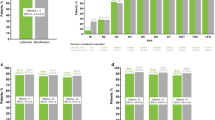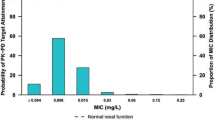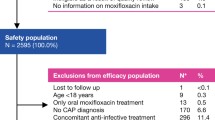Abstract
The objective of this study was to assess the efficacy and safety of moxifloxacin versus amoxicillin-clavulanate plus roxithromycin (comparator) in adult community-acquired pneumonia (CAP) patients with risk factors. In this comparative, randomized, multicenter, open-label study, patients hospitalized for CAP received a 10-day oral treatment with either moxifloxacin (400 mg o.d.) or amoxicillin-clavulanate (1,000/125 mg t.i.d.) plus roxithromycin (150 mg b.i.d.). Clinical and bacteriological outcomes were assessed during test of cure and follow-up visits (5–7 days and 21–28 days after the end of treatment, respectively). Of 349 randomized patients, 346 were included in the intent-to-treat analysis and 289 in the per-protocol analysis. Their baseline characteristics were comparable. The most frequent risk factors for mortality were age >65 years (50.0%), alcoholism (23.1%), and comorbidities (50.6%); chronic obstructive pulmonary disease (COPD) (25.4%) and diabetes mellitus (13.6%) were the most common associated comorbidities. A causative pathogen was documented in 66 of 346 (19.1%) of the patients (including 21 with positive blood cultures). Respective per-protocol clinical success rates at test-of-cure (primary efficacy endpoint) for moxifloxacin and comparator were 131 of 151 (86.8%) and 120 of 138 (87.0%), with a 95% confidence interval (CI) of −8.0–7.6 for the difference. Bacteriological success rates (eradication) were 23 of 30 (76.7%) and 23 of 31 (74.2%); rates for patients with positive blood cultures were 10 of 14 and 4 of 6. Persistent clinical success rates at follow-up were 118 of 120 (98.3%) and 102 of 106 (96.2%), with a 95%CI of −2.2–6.4 for the difference. The intent-to-treat analysis confirmed these results. Adverse events associated with moxifloxacin and the comparator drug were reported for 42 of 171 (24.6%) and 50 of 175 (28.6%) of the patients, respectively, and comprised predominantly digestive disorders, which occurred in 9.4% and 21.1%. On the basis of these results, once-daily oral moxifloxacin alone is as effective as amoxicillin-clavulanate plus roxithromycin for the treatment of CAP in patients with risk factors.

Similar content being viewed by others
References
Fine MJ, Auble TE, Yealy DM, et al (1997) A prediction rule to identify low-risk patients with community-acquired pneumonia. N Engl J Med 336:243–250
Brown PD, Lerner SA (1998) Community-acquired pneumonia. Lancet 352:1295–1302
Boersma WG (1999) Assessment of severity of community-acquired pneumonia. Semin Respir Infect 14:103–114
Diaz Fuenzalida A, Vera C, Santamarina J, et al (1999) Community-acquired pneumonia in the elderly requiring hospitalization. Clinical features and prognosis. Medicina (B Aires) 59:731–738
Merchant S, Mullins CD, Shih YC (2003) Factors associated with hospitalization costs for patients with community-acquired pneumonia. Clin Ther 25:593–610
Agence Française de Sécurité Sanitaire des Produits de Santé (2002) Antibiothérapie par voie générale en pratique courante: infections respiratoires basses de l’adulte. Méthode générale, recommandations et argumentaire. Réactualisation 2002. http://agmed.sante.gouv.fr/htm/5/rbp/indrbp.htm. Cited 24 January 2003
Société de pathologie infectieuse de langue française (2000) Révision de la IVe Conférence de consensus en thérapeutique anti-infectieuse de la Société de pathologie infectieuse de langue française (SPILF). Prise en charge des infections des voies respiratoires basses. Méd Mal Infect 30:565–580
Nightingale CH (2000) Moxifloxacin, a new antibiotic designed to treat community-acquired respiratory tract infections: a review of microbiologic and pharmacokinetic-pharmacodynamic characteristics. Pharmacotherapy 20:245–256
Balfour JA, Wiseman LR (1999) Moxifloxacin. Drugs 57:363–373
Boswell FJ, Andrews JM, Jevons G, et al (2002) Comparison of the in vitro activities of several new fluoroquinolones against respiratory pathogens and their abilities to select fluoroquinolone resistance. J Antimicrob Chemother 50:495–502
Bebear CM, Renaudin H, Boudjadja A, et al (1998) In vitro activity of BAY 12-8039, a new fluoroquinolone against mycoplasmas. Antimicrob Agents Chemother 42:703–704
Roblin PM, Hammerschlag MR (1998) In vitro activity of a new 8-methoxyquinolone, BAY 12-8039, against Chlamydia pneumoniae. Antimicrob Agents Chemother 42:951–952
Ruckdeschel G, Dalhoff A (1999) The in-vitro activity of moxifloxacin against Legionella species and the effects of medium on susceptibility test results. J Antimicrob Chemother 43 (Suppl B):25–29
Jardim JR, Rico G, de la Roza C, et al (2003) A comparison of moxifloxacin and amoxicillin in the treatment of community-acquired pneumonia in Latin America: results of a multicenter clinical trial. Arch Bronconeumol 39:387–393
Torres A, Muir JF, Corris P, et al (2003) Effectiveness of oral moxifloxacin in standard first-line therapy in community-acquired pneumonia. Europ Respir J 21:135–143
Finch R, Schurmann D, Collins O, et al (2002) Randomized controlled trial of sequential intravenous (i.v.) and oral moxifloxacin compared with sequential i.v. and oral co-amoxiclav with or without clarithromycin in patients with community-acquired pneumonia requiring initial parenteral treatment. Antimicrob Agents Chemother 46:1746–1754
Hoeffken G, Meyer HP, Winter J, et al (2001) The efficacy and safety of two oral moxifloxacin regimens compared to oral clarithromycin in the treatment of community-acquired pneumonia. Respir Med 95:553–564
Petitpretz P, Arvis P, Marel M, et al (2001) Oral moxifloxacin vs. high-dosage amoxicillin in the treatment of mild-to-moderate, community-acquired, suspected pneumococcal pneumonia in adults. Chest 119:185–195
Patel T, Pearl J, Williams J, et al (2000) Efficacy and safety of ten-day moxifloxacin 400 mg once daily in the treatment of patients with community-acquired pneumonia. Community Acquired Pneumonia Study Group. Respir Med 94:97–105
Ruiz M, Ewig S, Marcos MA, et al (1999) Etiology of community-acquired pneumonia: impact of age, comorbidity, and severity. Am J Respir Crit Care Med 160:397–405
Saldias Penafiel F, O’Brien Solar A, Gederlini Gollerino A, et al (2003) Community-acquired pneumonia requiring hospitalization in immunocompetent elderly patients: clinical features, prognostic factors and treatment. Arch Bronconeumol 39:333–340
Meehan TP, Chua-Reyes JM, Tate J, et al (2000) Process of care performance, patient characteristics, and outcomes in elderly patients hospitalized with community-acquired or nursing home-acquired pneumonia. Chest 117:1378–1385
European Agency for the Evaluation of Medicinal Products (2000) Committee for Proprietary Medicinal Products (CPMP): points to consider on switching between superiority and non-inferiority. CPMP/EWP/482/99 (27 July 2000). http://www.emea.eu.int/pdfs/human/ewp/0482/99en.pdf
Man I, Murphy J, Ferguson J (1999) Fluoroquinolone phototoxicity: a comparison of moxifloxacin and lomefloxacin in normal volunteers. J Antimicrob Chemother 43 (Suppl B):77–82
Cubeddu LX (2003) QT prolongation and fatal arrhythmias: a review of clinical implications and effects of drugs. Am J Ther 10:452–457
Jaillon P, Morganroth J, Brumpt I, et al (1996) Overview of electrocardiographic and cardiovascular safety data for sparfloxacin. Sparfloxacin Safety Group. J Antimicrob Chemother 37 (Suppl A):161–167
Stahlmann R, Schwabe R (1997) Safety profile of grepafloxacin compared with other fluoroquinolones. J Antimicrob Chemother 40 (Suppl A):83–92
Acknowledgements
This work was supported by a research grant from Bayer Pharma, France. The corresponding author, as principal investigator, received grants for the coordination of the study. He and the other members of the IZIPAC Study Group Scientific Committee received grants for their review and individual validation of the patient cases. These financial sources have not in any way had an impact on either the selection and interpretation of published data or the preparation of this manuscript. Members of the IZIPAC Study Group: Scientific Committee: C. Brambilla, M. Garre, H. Portier, and P. Zuck. Investigators: F. Al Freijat, H. Berard, F. Benhamou, F. Bonnaud, A. Bosseray, O. Bouchard, J. Boyer, P. Brouqui, R. Cevallos, J.M. Chavaillon, C. Chidiac, H. De Cremoux, P. Dellamonica, B. Desurmont-Salasc, P. Duguet, M. Dupon, B. Duvert, D. Debieuvre, M.C. Dombret, P. Dore, J.M. Estavoyer, L. Falchero, E. Fournier, M. Garre, D. Gora, F. Goutorbe, J.R. Harle, D. Herman, J. Hermann, B. Herer, A. Huchon, R. Jaussaud, C. Jordy, H. Jullian, S. Khatibi, R. Lachaussée, A. Lagier, T. Langin, P. Laurent, T. Lazard, F.X. Lebas, F. Lecomte, P. Leophonte, G. Lepeu, B. Lorcerie, P. Loste, D. Malvy, G. Mangiapan, Y. Martinet, T. May, P. Meekel, V. Meunier, D. Merrien, P. Morlat, M. Mornet, G. Nouvet, F. Paganin, J.C. Pellegrin, H. Portier, P. Poubeau, T. Prazuck, A. Proust, A. Prud’homme, F. Roblot, J. Rottner, D. Salmon, J. Seigneur, T. Simon, J.P. Stahl, M. Thomas, A. Tonnel, J.P. Vagneur, C. Verkindre, P. Vinceneux, M.A. Vincent, P.M. Viso, L. Vives, P. Vivet, Y. Zein, and P. Zuck
Author information
Authors and Affiliations
Corresponding author
Rights and permissions
About this article
Cite this article
Portier, H., Brambilla, C., Garre, M. et al. Moxifloxacin monotherapy compared to amoxicillin-clavulanate plus roxithromycin for nonsevere community-acquired pneumonia in adults with risk factors. Eur J Clin Microbiol Infect Dis 24, 367–376 (2005). https://doi.org/10.1007/s10096-005-1347-1
Published:
Issue Date:
DOI: https://doi.org/10.1007/s10096-005-1347-1




